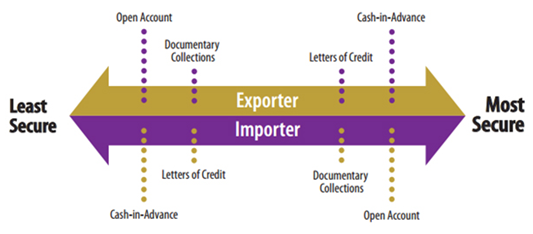Characteristics of Cash in Advance

Applicability
Recommended for use in high-risk trade relationships or export markets, and appropriate for export transactions.
Risk
Exporter is exposed to virtually no risk as the burden of risk is placed almost completely on the importer.
Pros
Payment before shipment
Eliminates risk of non-payment
Cons
No additional earnings through financing operations
Wire Transfer: Most Secure and Preferred Cash-in-Advance Method
An international wire transfer is commonly used and is almost immediate. Exporters should provide clear routing instructions to the importer when using this method, including the receiving bank’s name and address, SWIFT (Society for Worldwide Interbank Financial Telecommunication) address, as well as the seller’s name and address, bank account title, and account number.
Escrow Service: A Mutually Beneficial Cash-in-Advance Method
Exporters may select escrow services as a mutually beneficial cash-in-advance option for transactions with importers who demand assurance that the goods will be sent in exchange for advance payment.
Escrow in international trade is a service that allows both exporter and importer to protect a transaction by placing the funds in the hands of a trusted third party until a specified set of conditions are met. Here’s how it works: the importer sends the agreed amount to the escrow service.
After payment is verified, the exporter is instructed to ship the goods. Upon delivery, the importer has a pre-determined amount of time to inspect and accept the goods. Once accepted, the funds are released by the escrow service to the exporter.
The escrow fee can either be paid in full by one party or split evenly between the exporter and the importer. Cross-border escrow services are offered by international banks and firms that specialize in escrow and other deposit and custody services

